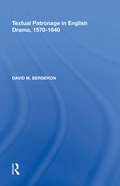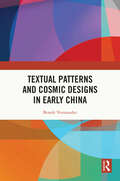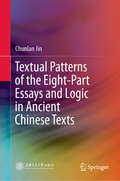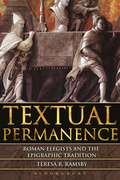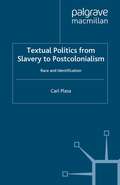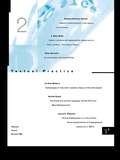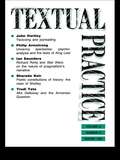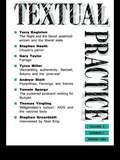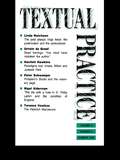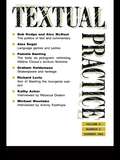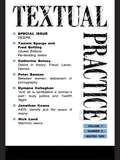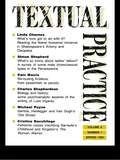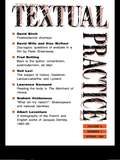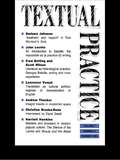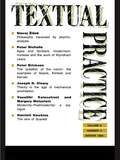- Table View
- List View
Textual Magic: Charms and Written Amulets in Medieval England
by Katherine Storm HindleyAn expansive consideration of charms as a deeply integrated aspect of the English Middle Ages. Katherine Storm Hindley explores words at their most powerful: words that people expected would physically change the world. Medieval Europeans often resorted to the use of spoken or written charms to ensure health or fend off danger. Hindley draws on an unprecedented archive of more than a thousand such charms from medieval England—more than twice the number gathered, transcribed, and edited in previous studies and including many texts still unknown to specialists on this topic. Focusing on charms from 1100 to 1350 CE as well as previously unstudied texts in Latin, French, and English, Hindley addresses important questions of how people thought about language, belief, and power. She describes seven hundred years of dynamic, shifting cultural landscapes, where multiple languages, alphabets, and modes of transmission gained and lost their protective and healing power. Where previous scholarship has bemoaned a lack of continuity in the English charms, Hindley finds surprising links between languages and eras, all without losing sight of the extraordinary variety of the medieval charm tradition: a continuous, deeply rooted part of the English Middle Ages.
Textual Metonymy: A Semiotic Approach
by A. Al-SharafiTextual Metonymy employs a theoretical framework combining rhetoric, figurative theory and textlinguistics. In the process, a very full historical account of treatments of metonymy from classical traditions up to the present time is given and critiqued. The author proposes a semiotic approach to the treatment of metonymy, on the basis of which a textual model of metonymy as a process of representation is developed to account for text cohesion and text coherence.
Textual Patronage in English Drama, 1570-1640
by David M. BergeronThrough an investigation of the dedications and addresses from various printed plays of the English Renaissance, the author recuperates the richness of these prefaces and connects them to the practice of patronage. The prefatory matter discussed ranges from the printer John Day's address to readers (the first of its kind) in the 1570 edition of Gorboduc to Richard Brome's dedication to William Seymour and address to readers in his 1640 play, Antipodes. The study includes discussion of prefaces in plays by Shakespeare's contemporaries as well as Shakespeare himself, among them Marston, Jonson, and Heywood. The author uses these prefaces to show that English playwrights, printers and publishers looked in two directions, toward aristocrats and toward a reading public, in order to secure status for and dissemination of dramatic texts. The author points out that dedications and addresses to readers constitute obvious signs that printers, publishers and playwrights in the period increasingly saw these dramatic texts as occupying a rightful place in the humanistic and commercial endeavor of book production.
Textual Patronage in English Drama, 1570-1640
by David M. BergeronThrough an investigation of the dedications and addresses from various printed plays of the English Renaissance, the author recuperates the richness of these prefaces and connects them to the practice of patronage. The prefatory matter discussed ranges from the printer John Day's address to readers (the first of its kind) in the 1570 edition of Gorboduc to Richard Brome's dedication to William Seymour and address to readers in his 1640 play, Antipodes. The study includes discussion of prefaces in plays by Shakespeare's contemporaries as well as Shakespeare himself, among them Marston, Jonson, and Heywood. The author uses these prefaces to show that English playwrights, printers and publishers looked in two directions, toward aristocrats and toward a reading public, in order to secure status for and dissemination of dramatic texts. The author points out that dedications and addresses to readers constitute obvious signs that printers, publishers and playwrights in the period increasingly saw these dramatic texts as occupying a rightful place in the humanistic and commercial endeavor of book production.
Textual Patterns and Cosmic Designs in Early China
by Benoît VermanderVia a hermeneutics focused on Chinese numerology and concentric arrangements, this book offers a novel construal of the textual universe proper to early China writings.The author lays bare distinguishable patterns of textual composition while relating them to corresponding patterns of thinking. He differentiates rhetorical variants through detailed studies of the Zhuangzi’s Inner chapters, the Laozi, the Analects, and the Huainanzi. The philosophical depth and relevance of the Chinese ancient worldview appear in a fresh light when one unearths the patterns into which its content is embedded. The focus on textual patterns and rhetorical arrangements also facilitates the reading of Chinese classics alongside other traditions.The book will be a valuable reference for scholars and graduate students studying Chinese literary criticism, Chinese philosophy, and comparative philosophy.
Textual Patterns and Cosmic Designs in Early China
by Benoît VermanderVia a hermeneutics focused on Chinese numerology and concentric arrangements, this book offers a novel construal of the textual universe proper to early China writings.The author lays bare distinguishable patterns of textual composition while relating them to corresponding patterns of thinking. He differentiates rhetorical variants through detailed studies of the Zhuangzi’s Inner chapters, the Laozi, the Analects, and the Huainanzi. The philosophical depth and relevance of the Chinese ancient worldview appear in a fresh light when one unearths the patterns into which its content is embedded. The focus on textual patterns and rhetorical arrangements also facilitates the reading of Chinese classics alongside other traditions.The book will be a valuable reference for scholars and graduate students studying Chinese literary criticism, Chinese philosophy, and comparative philosophy.
Textual Patterns of the Eight-Part Essays and Logic in Ancient Chinese Texts
by Chunlan JinThis book systematically depicts the theory of textual patterns (chengshi) of the eight-part essays and logic in ancient Chinese texts. With the rare materials, it covers all the basic and important aspects of the whole process and values of chengshi, such as the transformation of different parts and the coherent expression of the doctrines, the planning of writing, and the application to the aesthetic and pedagogic fields. It also explores the similarities and disparities of logical patterns between ancient Chinese and Western texts. Though entirely fresh and tentative, the contrastive studies get new insights into the logic and philosophical concepts hidden in the writings for better understanding of the uniqueness and richness implied in Chinese culture.
Textual Permanence: Roman Elegists and Epigraphic Tradition
by Teresa RamsbyTextual Permanence is the first book to examine the influence of the Roman epigraphic tradition on Latin elegiac poetry. The frequent use of invented inscriptions within the works of Rome's elegiac poets suggests a desire to monumentalise elements of the poems and the authors themselves. This book explores inscriptional writing in the elegies of Catullus, Propertius, Tibullus and Ovid, showing that whenever an author includes an inscription within a poem, he draws the reader's attention beyond the text of the poem to include the cultural contexts in which such inscriptions were daily read and produced. The emphases that these inscriptions grant to persons, sentiments and actions within the poems are reflections of the permanence that real-life inscriptions grant to a variety of human efforts. These poetic inscriptions provide unique windows of interpretation to some of Rome's most significant and influential poems.Teresa Ramsby traces an important relationship between the Roman tradition that honoured individual participation in Roman politics, and the way that elegiac poetry was early applied in Rome to the same activity. In the course of the book she offers fresh interpretations of poems that have been analysed by a host of scholars.
Textual Permanence: Roman Elegists and Epigraphic Tradition
by Teresa RamsbyTextual Permanence is the first book to examine the influence of the Roman epigraphic tradition on Latin elegiac poetry. The frequent use of invented inscriptions within the works of Rome's elegiac poets suggests a desire to monumentalise elements of the poems and the authors themselves. This book explores inscriptional writing in the elegies of Catullus, Propertius, Tibullus and Ovid, showing that whenever an author includes an inscription within a poem, he draws the reader's attention beyond the text of the poem to include the cultural contexts in which such inscriptions were daily read and produced. The emphases that these inscriptions grant to persons, sentiments and actions within the poems are reflections of the permanence that real-life inscriptions grant to a variety of human efforts. These poetic inscriptions provide unique windows of interpretation to some of Rome's most significant and influential poems.Teresa Ramsby traces an important relationship between the Roman tradition that honoured individual participation in Roman politics, and the way that elegiac poetry was early applied in Rome to the same activity. In the course of the book she offers fresh interpretations of poems that have been analysed by a host of scholars.
Textual Politics from Slavery to Postcolonialism: Race and Identification
by C. PlasaThis book explores questions of race and identification in writings from the Enlightenment to the present. Drawing on post-colonial theory, it provides close readings of texts by Olaudah Equiano, Jane Austen, Charlotte Brontë, Jean Rhys, Frantz Fanon, Toni Morrison and Tsitsi Dangarembga and highlights the elements of dialogue, exchange and contestation between them. It illustrates how inscriptions of racial crossing - whether between white and black or black and white - are always implicated in a certain textual and/or intertextual politics.
Textual Practice: Volume 9 Issue 2
by Daphna Erdinast-Vulcan J. Hillis Miller Peter Nicholls Jo-Ann Wallace Harriet Guest Laurie E. OsborneFirst published in 1995. Routledge is an imprint of Taylor & Francis, an informa company.
Textual Practice: Volume 8, Issue 3
by Terence HawkesFirst published in 1994. Routledge is an imprint of Taylor & Francis, an informa company.
Textual Practice: Volume 8, Issue 1
by Terence HawkesFirst published in 1994. Routledge is an imprint of Taylor & Francis, an informa company.
Textual Practice: Volume 8, Issue 2
by Terence HawkesFirst published in 1994. Routledge is an imprint of Taylor & Francis, an informa company.
Textual Practice: Volume 6, Issue 2
by Terence HawkesFirst published in 1992. Routledge is an imprint of Taylor & Francis, an informa company.
Textual Practice: Volume 6, Issue 2
by Terence HawkesFirst published in 1992. Routledge is an imprint of Taylor & Francis, an informa company.
Textual Practice: Volume 7, Issue 3: Special Issue: Desire
by Terence HawkesFirst published in 1993. Routledge is an imprint of Taylor & Francis, an informa company.
Textual Practice: Volume 7, Issue 3: Special Issue: Desire
by Terence HawkesFirst published in 1993. Routledge is an imprint of Taylor & Francis, an informa company.
Textual Practice: Volume 6, Issue 1
by Terence HawkesFirst published in 1992. Routledge is an imprint of Taylor & Francis, an informa company.
Textual Practice: Volume 6, Issue 1
by Terence HawkesFirst published in 1992. Routledge is an imprint of Taylor & Francis, an informa company.
Textual Practice: Volume 5, Issue 1
by Terence HawkesFirst published in 1991. Routledge is an imprint of Taylor & Francis, an informa company.
Textual Practice: Volume 5, Issue 1
by Terence HawkesFirst published in 1991. Routledge is an imprint of Taylor & Francis, an informa company.
Textual Practice: Volume 7, Issue 2
by Terence HawkesFirst published in 1993. Routledge is an imprint of Taylor & Francis, an informa company.
Textual Practice: Volume 6, Issue 3
by Terence HawkesFirst published in 1992. Routledge is an imprint of Taylor & Francis, an informa company.
Textual Practice: Volume 6, Issue 3
by Terence HawkesFirst published in 1992. Routledge is an imprint of Taylor & Francis, an informa company.


